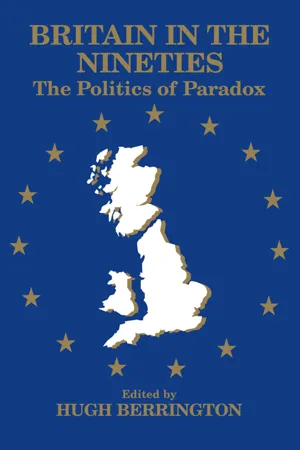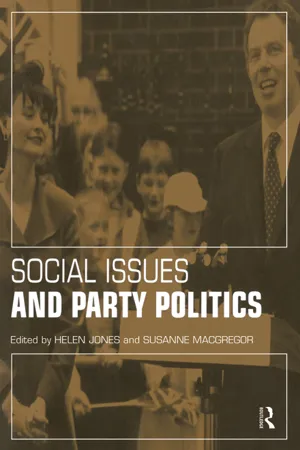History
1997 General Election
The 1997 General Election in the UK marked a significant political shift, with the Labour Party, led by Tony Blair, securing a landslide victory after 18 years of Conservative rule. This election saw the largest swing to a single party since 1945, leading to a major overhaul of policies and the beginning of a new era in British politics.
Written by Perlego with AI-assistance
Related key terms
3 Key excerpts on "1997 General Election"
- eBook - ePub
Labour's Conscience
The Labour Left, 1945-51
- Jonathan Schneer(Author)
- 2018(Publication Date)
- Routledge(Publisher)
2Helpful as previous work on the general election has been, we may push our knowledge further by focusing upon the Labour Left during the campaign. On the most basic level this helps fill a gap in the literature; since, despite its significant role during the contest, historians never have considered the Labour Left’s impact. Moreover, the lessons and conclusions which many left-wing Labourites derived from the general election were to influence significantly their later behavior. In fact, when one views it in the refracted light of subsequent Labour Left disillusionment with Attlee’s governments, the 1945 election takes on new meaning. That light endows the campaign with a poignancy and irony missing from other accounts. It makes a more nuanced interpretation of this crucial event possible. The paradox of 1945, as I hope to demonstrate, is that it set the stage for Labour’s great achievements under Attlee’s Prime Ministership—but also for Bevan’s climactic Labour Left rebellion of 1951.3II
The background to the general election is uncontroversial, but there is one point of significance which often has been forgotten. The flat-out contest for supremacy between Labour and Conservatives which took place during the campaign might not have occurred, had it not been for the Labour Left.When Churchill announced the general election neither he nor a majority of his Cabinet wanted an end to the political truce that had been more or less in effect in Britain since the beginning of the war. Most of the Labour ministers continued to hope that the coalition government would remain in power at least until victory over Japan had been won; not knowing of the atomic bomb, they thought this victory might take several years to achieve. That Labour fought the general election not to improve its position against the Conservatives in the coalition, but in hopes of achieving outright victory, was largely a result of pressure emanating from the party rank and file, most forcefully articulated by Harold Laski, Aneurin Bevan and Emanuel Shinwell, representatives of the Left on Labour’s National Executive Committee. They convinced Herbert Morrison and William Whitely, Labour’s chief whip in the House of Commons, that the party would not accept continued coalition government. Attlee, Bevin and Dalton, who argued to the contrary, were outvoted at a meeting of Labour’s National Executive Committee. Thus the most successful general election in Labour Party history was due in part to a victory of the rank and file, and of the Labour Left, over the party leaders.4 - eBook - ePub
Britain in the Nineties
The Politics of Paradox
- Hugh Berrington(Author)
- 2014(Publication Date)
- Routledge(Publisher)
potentially more volatile than in the past. The fact that this potential had not been fully realised did not mean that it did not exist.1992–97: DEALIGNMENT VINDICATED?In terms of the trends in party support, the period between the 1992 and 1997 elections was extraordinary. A slump in the popularity of the governing party, followed by a recovery as the next election approaches, is a familiar aspect of the inter-election cycle in Britain (as elsewhere) but the 1992–97 cycle set new records. The Conservatives experienced their worst-ever local election defeats, received their lowest vote share of the century in a national election (27.9 per cent) in the election to the European Parliament in June 1994, and lost all eight of the seats they defended in parliamentary by-elections. In the monthly opinion polls, the Conservative share of voting intentions plunged further and faster than ever before and the gap between the government and the opposition was larger and longer-lasting than in any previous cycle. Between 1987 and 1992, for example, Labour had led the Conservatives by more than ten per cent for 12 months; between 1992 and 1997 Labour’s lead was more than 20 per cent for 39 months. On the basis of previous experience, politicians and pundits waited expectantly for the gap to narrow significantly as the 1997 election approached, but it never did. Although the Conservatives recovered a little from their truly disastrous poll ratings in early 1995, they never looked like threatening Labour’s lead and were still 25 points behind in March 1997.During this cycle the Conservatives lost three of the significant electoral advantages that they had previously enjoyed. The first was in terms of leaders. Although John Major had been preferred by the electorate over Neil Kinnock, he soon came to be seen as weak and indecisive. In July 1992 Kinnock was replaced as Labour leader by John Smith. Within three months, Smith overtook Major as the most preferred prime minister, and over his 21-month term as leader he was preferred, on average, by 32 per cent of Gallup’s respondents, compared with 22 per cent for Major and 20 per cent for Paddy Ashdown, leader of the Liberal Democrats. Following John Smith’s death, Tony Blair became Labour leader in July 1994. Almost as soon as Blair was elected, he established a commanding lead over his rivals as the party leader thought likely to make the best prime minister. From August to December 1994 he was preferred on average by 41 per cent of the ‘Gallup 9000’ compared with 16 per cent for Major and 14 per cent for Ashdown. During the next 12 months the average figures were 42 per cent for Blair, 17 per cent for Major and 13 per cent for Ashdown, while for 1996 they were 39 per cent for Blair, 19 per cent for Major and 14 per cent for Ashdown. For the first time for many years the Conservatives faced a general election with a leader who was much less popular with the electorate than his main rival. - eBook - ePub
- Helen Jones, Susanne MacGregor(Authors)
- 2005(Publication Date)
- Routledge(Publisher)
Chapter 1The road to 1997
Helen JonesTHE SUN SHINES ON BLAIR
On 17 March John Major, and on 2 May Tony Blair, provided the 1997 General Election with a symbolic stage-managed symmetry. John Major, following a format he instigated in 1992, stood alone and isolated in Downing Street to announce 1 May as Polling Day. He used the occasion to launch the formal campaign (a phoney one had been underway for at least a year) with a party-political plea for the Conservatives. Six and a half weeks later Tony Blair walked up Downing Street (the formality and separation from the people of an official car abandoned) with a youthful and apparently happy family to the cheers and flag-waving of hand-picked party workers. These strong and contrasting images—of John Major, formal and isolated from party and people and Tony Blair, informal and surrounded by loyal supporters—were present throughout the campaign. Both parties put enormous effort into trying to control the media's presentation of their leaders. Labour succeeded, but the Conservatives failed miserably, not least because the bulk of newspapers were no longer, as in previous General Elections, the willing accomplices of the Conservative Party.The way in which the parties presented their leaders and aimed to control the media affected the conduct of the campaign which some commentators believed signalled the growing ‘Americanisation’ of British elections with a more presidential style campaign, focusing on the leader, not the party. A live TV debate between candidates for the Presidency is an accepted event in American elections. Negotiations (conducted in private between Lord Irvine for Labour and Michael Dobbs for the Conservatives and slogged out in public between Peter Mandelson and Brian Mawhinney) to present a live TV debate between John Major and Tony Blair became a part of the campaign, foundering largely on the ‘Paddy problem’, that is, what role Paddy Ashdown, leader of the Liberal Democrats, should play. The Conservatives paid a man to dress up in a yellow chicken suit with a placard ‘Chicken Blair Won't Debate’ to chase Blair until he agreed to a live TV debate. (This was another echo of the 1992 presidential campaign.) The chicken spawned a whole zoo of animals posing for photographers, but it did little to leaven the Conservatives' gloom.
Learn about this page
Index pages curate the most relevant extracts from our library of academic textbooks. They’ve been created using an in-house natural language model (NLM), each adding context and meaning to key research topics.


